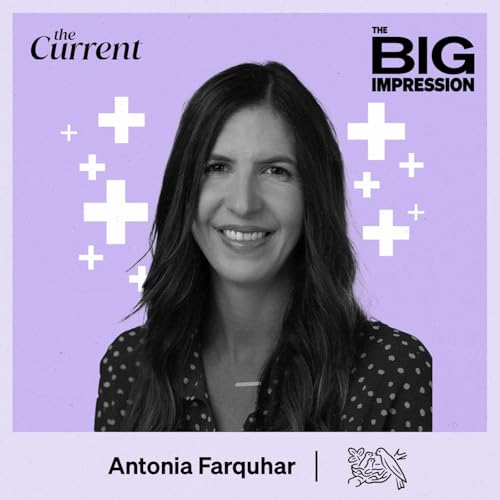Discover how Kate Wik, CMO of Las Vegas, drives bold innovation and storytelling to transform the city into a global destination brand. Episode TranscriptPlease note, this transcript may contain minor inconsistencies compared to the episode audio. Damian Fowler (00:00):I'm Damian Fowler.Ilyse Liffreing (00:01):And I'm Ilyse Liffreing.Damian Fowler (00:02):And welcome to this edition of The Big Impression.Ilyse Liffreing (00:09):Today we're joined by Kate Wik, chief Marketing Officer at the Las Vegas Convention and Visitors Authority. The team behind the city's newest brand campaign, which launched in September,Damian Fowler (00:20):Las Vegas, is known around the world for its energy, its entertainment, and its edge. But this ladies' campaign takes a closer look at what the city means today beyond the casinos and into its growing identity as a cultural and sports destination.Ilyse Liffreing (00:34):We'll talk with Kate about the ideas behind the campaign, how Vegas is connecting with new audiences, and what it takes to evolve one of the most recognizable brands in the world. Q,Damian Fowler (00:45):Frank Sinatra. It's okay. You have an unusual role in that you represent a city as an iconic one, but could you tell us about the role?Kate Wik (00:56):That's exactly right. So I work for the Las Vegas Convention and Visitors Authority. Nobody knows what that is or what that means. So really, I shorthand it and I say I am the CMO of four Las Vegas. Las Vegas is my product, which is very unique. It is a city, it's a destination. It's unbelievably dynamic. And what's so unique and thrilling for a CMO of Las Vegas is that our product is always changing, always evolving. If you think back, we were known as the gaming destination. We've evolved into, we're the number one hospitality destination in the US with more hotel rooms than any other destination. And we are the entertainment capital of the world. You've got the world's best artists coming and performing on stages across destination every single night. And we've worked really hard to evolve ourselves into the sports destination as well through a lot of recent things. So really the exciting thing for me in this role is no one day is ever the same. Our product is constantly iterating and evolving, and that is a marketer's dream come true.Damian Fowler (02:10):Just on that point about the evolution of the city and the perception of it, how fast has that happened in the last, say, five, 10 years?Kate Wik (02:20):Yeah, absolutely. Incredibly fast. And so today we are known as the sports and entertainment capital of the world, but less than 10 years ago, we did not have any sports teams. Yes, sports has kind of always been in our DNA. We'd host major boxing matches in the eighties, NFR we've had for decades. NBA, we hosted their in-season tournament, NBA Summer League, but really it was through infrastructure development that really led to the explosion of sports today. So what I mean by that is we had T-Mobile Arena, which was a joint venture between MGM resorts and a EG that enabled NHL to come to town with the Vegas Golden Knights in 20 17, 20 18, we purchased the WNBA team, which we renamed the Las Vegas ACEs. And so now we've got A-W-N-B-A team. And then in 2020, of course with Allegiant Stadium, we welcome the Raiders. And so now we've got the Las Vegas Raiders, and we are, so actually in four years, we went from having zero professional sports teams to having three, and we're actively working to bring our fourth to town, which is the major league baseball. We're welcoming the Las Vegas a,Damian Fowler (03:34):Not to mention Formula One.Kate Wik (03:36):Yes, exactly. And Formula One now an annual event on our calendar. So it's a lot. It's a lot. And it creates new reasons to come to Las Vegas for our visitors. And what we found through research actually, is that the sports traveler, number one, we know sports tourism has just exploded the sports traveler. Through our research, we found that it creates a new reason to come to Las Vegas for those that haven't been here before. It creates a reason to explore the destination, see it, consider it, and then ultimately come. And then most importantly, we find that they spend more money than the average leisure traveler. So it's a really rich new audience for Las Vegas. And F1 has definitely exploded that for us too.Ilyse Liffreing (04:24):Do you know by just how much more do they spend?Kate Wik (04:27):It's usually anywhere from 500 to 800 more per trip.Ilyse Liffreing (04:31):Wow, that's a lot. And the rest on gambling,Kate Wik (04:36):AnythingIlyse Liffreing (04:36):Extra? It'sKate Wik (04:37):Funny. Gambling hasn't been, revenue from gaming hasn't been the primary source of how consumers are spending their budget while they're in town. Hasn't been that for over a decade.Ilyse Liffreing (04:51):AndKate Wik (04:51):I think it speaks to the diversification of the experience in Las Vegas. And when I say we're ...
Show more
Show less
 29 mins
29 mins Nov 19 202526 mins
Nov 19 202526 mins Nov 12 202526 mins
Nov 12 202526 mins 21 mins
21 mins Oct 22 202525 mins
Oct 22 202525 mins 39 mins
39 mins 29 mins
29 mins 21 mins
21 mins
